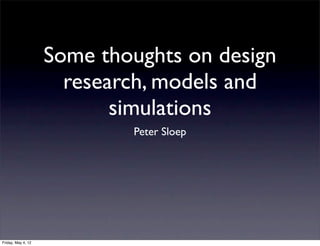some thoughts about design research
- 1. Some thoughts on design research, models and simulations Peter Sloep Friday, May 4, 12
- 2. Overview ŌĆó Part I: ŌĆśordinary researchŌĆÖ, the essentialia ŌĆó Part II: design research, the differences ŌĆó Part III: models Friday, May 4, 12
- 3. Caveat ŌĆó A quick and dirty introduction to some aspects of the philosophies of science and technology ŌĆó Sometimes less than accurate, sometimes plain wrong, but always in an attempt to be useful. Friday, May 4, 12
- 4. Ordinary research, aimed at understanding and control Friday, May 4, 12
- 5. Theoretical models Ia Ib S1 S2 S3 Ic Friday, May 4, 12
- 6. Theoretical models smoke therapy Ia Ib S1 S2 S3 healthy Ic cancer dead therapy Friday, May 4, 12
- 7. ŌĆó for a model to be useful, you need ŌĆó descriptive apparatus, vocabulary ŌĆó rules for how to use it, grammar, syntax ŌĆó rules that uses the vocabulary and syntax to describe possible model behaviours Friday, May 4, 12
- 8. ŌĆó rules about possible behaviours are interesting ŌĆó they are generalizations, subsume instances of model behaviour ŌĆó form: whenever X then Y Friday, May 4, 12
- 9. ŌĆó all kinds of vocabularies and syntaxes ŌĆó math.: diff. equations, ’¼ünite automata, probability calculus ŌĆó computer languages: Stella, Netlogo ŌĆó ordinary language (but formal languages are much more powerful because they allow inferences from axioms) Friday, May 4, 12
- 10. What use are models? ŌĆó Are the generalizations true of the world? ŌĆó you test a model ŌĆó predict future behaviour, check if it occurs ŌĆó yes: more con’¼üdence ŌĆó no: adapt or fully reject model Friday, May 4, 12
- 11. ŌĆó A word on statistics ŌĆó some models are stochastic, their behaviour is stochastic ŌĆó but all data are subject to chance variation; you use statistics for the latter, to quantify uncertainty in your decision to accept the model or reject it Friday, May 4, 12
- 12. What use are models? ŌĆó Are the generalizations useful in the world? ŌĆó you explain the world by using model generalizations on phenomena ŌĆó you control the world by using the model to predict phenomena Friday, May 4, 12
- 13. Design research, focused on artefact design for control Friday, May 4, 12
- 14. ŌĆó artefacts are designed and developed to help control the empirical world ŌĆó there always are desired phenomena, the artefact causes them to occur ŌĆó there thus is a targeted state of the world and an obtained state of the world Friday, May 4, 12
- 15. St Si So I Friday, May 4, 12
- 16. ŌĆó building an aeroplane to ’¼éy ŌĆó setting up an organization (bank) to lend money to investors ŌĆó building a learning network to facilitate competence development, creativity and knowledge sharing of non-formal learners Friday, May 4, 12
- 17. Artefactual models ŌĆó As the artefact is to perform a function, you now build a model that describes the artefactŌĆÖs behaviour, using bits and pieces of relevant theoretical models ŌĆó Such a model I call an artefactual model, to distinguish it from theoretical models Friday, May 4, 12
- 18. Test ŌĆó to the extent it incorporates theoretical models, con’¼üdence carries over from them ŌĆó to the extent it rests on untested assumptions (structural and parametric) you test it ŌĆó experts, independent tests ŌĆó you thus contribute to theor. model dev.! Friday, May 4, 12
- 19. Simulate ŌĆó Use the artefuactual model to explore the artefactŌĆÖs behaviour through simulations ŌĆó Empirical tests are costly, dangerous, unethical, etc. ŌĆó Simulations are pseudo-performance tests of the artefact ŌĆó They may lead to design improvements Friday, May 4, 12
- 20. Empirical test ŌĆó Carry out empirical tests of artefact performance ŌĆó effectiveness - gap between actual and desired behaviour ŌĆó ef’¼üciency - costs of obtaining desired performance level increase ŌĆó sustainability - costs of maintenance Friday, May 4, 12
- 21. How Friday, May 4, 12
- 22. Model ingredients 1. identify the system and its boundaries: draw a causal network 2. identify variables and constants 3. identify state variables (ŌĆślaws of successionŌĆÖ, variables that describe state transitions) and and input variables (variables that drive change) Friday, May 4, 12
- 23. 1. choose output variables, what changes you want to measure (could be a state variable) 2. choose a suitable modelling language ŌĆó analytic, using math. equations, often differential equations ŌĆó numerical, using computers, dedicated language, e.g. Netlogo, Stella, Brahms, ... Friday, May 4, 12























